On a warm, sunny morning, yellow lanceleaf coreopsis and purple bee balm blossoms sway in the breeze. Flitting from flower to flower, butterflies nuzzle into what seems to be a full nectar buffet.
The tubular blooms of towering stems of white foxglove beard-tongue lure bees, and a goldfinch pecks around for seeds.
If you pass by Lake Springfield Park’s Hilltop Pavilion picnic area this spring and summer, you may not get that bird’s-eye view of the 4.5-acre slope called Boulevard Prairie — aka the Beer Prairie, since Kansas City’s Boulevard Brewing Co. sponsored its planting last year.
What’s likely to catch your eye is the big picture: a wide swath of colorful native wildflowers where once there was only green grass.
Over the next few years, with help from future sponsors and volunteers, Springfieldians and visitors can expect to see as many as 30 more acres of prairies here, thanks to Springfield-Greene County Park Board’s Partnering for Prairies program.
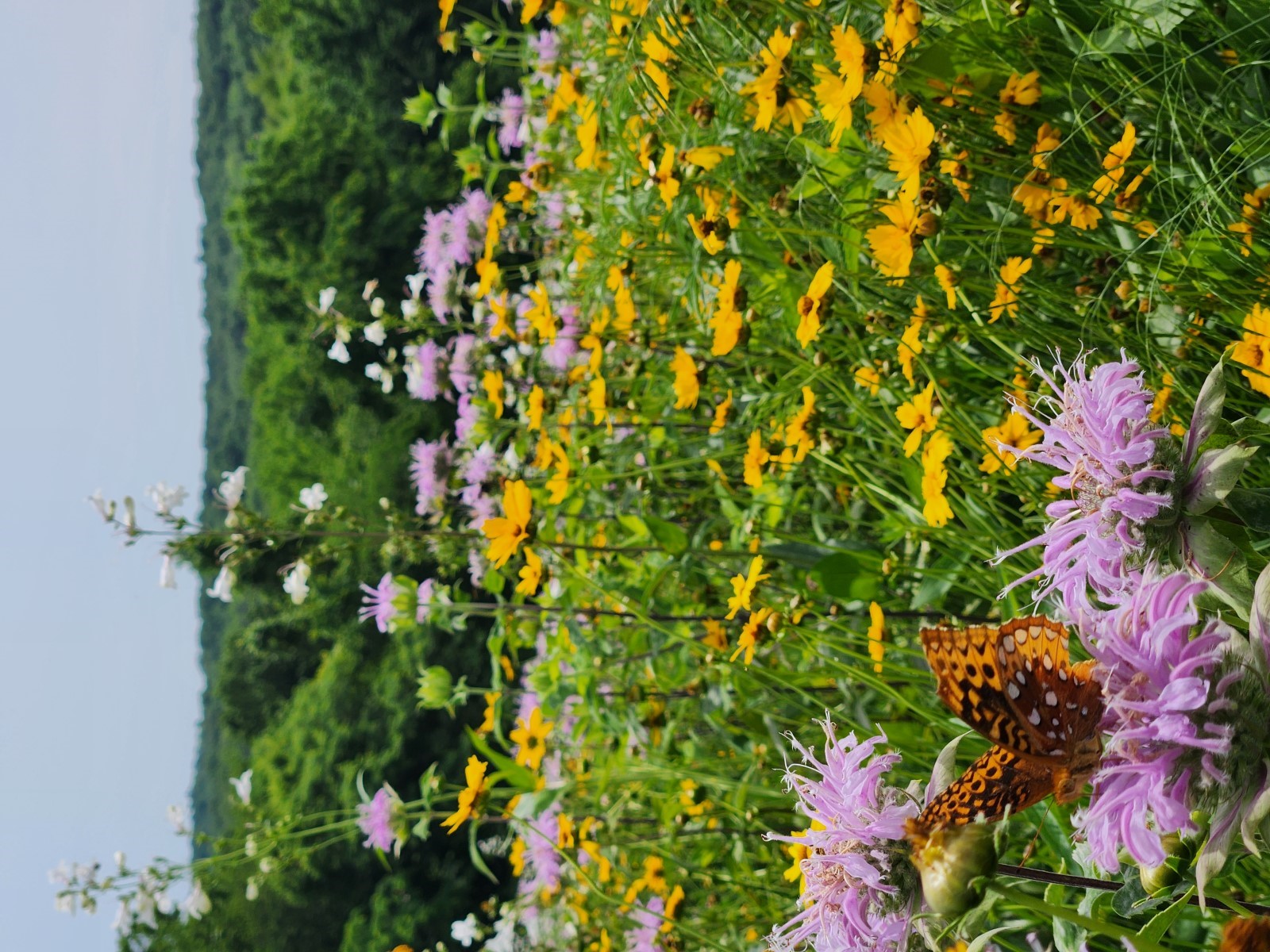
“Two and a half years ago, this was this,” Park Board caretaker Richard Locke said, gesturing toward a mowed expanse of grass that begins where the flowering prairie ends at the picnic area. “Anyway, this is only year two. Spring two.
“Incredible.”
Replacing little-used sections of park lawns that must be mowed with prairies will cut labor and fuel costs, solve erosion problems and restore wildlife habitats, said Park Board Conservation Coordinator Caleb Sanders.
Boulevard Prairie is part of Lake Springfield’s Wildlife Habitat Master Plan, and in its second spring of blooms, that’s already happening, Sanders said. Seeds and labor to plant the prairie cost about $2,000, yet more than $6,000 in mowing expenses have been saved over the past year, Sanders estimated.
“The proof’s in the pudding here,” he said. “What this is doing for the experience, for nature, our bottom dollar here at parks, is phenomenal. If we can make it look like this, we’re really hopeful we can think about replicating it in some other areas.”
Teamwork and transformation of the prairie

When Sanders says “we,” he means it.
Walking among the prairie’s wildflowers in late May, Sanders isn’t alone. Wearing a lime green T-shirt with the word “CREW” on the back, his friend Richard Locke is right behind him, stopping occasionally to aim the lens of a Nikon camera at bees and butterflies.
Not present for the morning tour is their friend Matt Coats, yet the two speak often of the board’s special facilities supervisor, just as they mention the work of other park employees and scouting volunteers.
A prairie to cover half a hillside might have been his idea, Sanders said, “but it’s 100-percent a park project.”
“Everybody plays a part,” Locke added.
Sanders echoed, “Everybody plays a part in this, and that’s what’s great.”
Invasive honeysuckle started a prairie project
The teamwork and transformation at the lake park started around 2016, after Coats became a facilities supervisor and moved his office to the boathouse. Soon, with a little research and some consulting with the Missouri Department of Conservation, the former park ranger realized he had a big problem on his hands: Invasive bush honeysuckle had choked out native wildlife habitats.
“It was sad, really,” said Coats, whose college degree is in wildlife management. “I’ve always had a passion for wildlife and native habitat.”
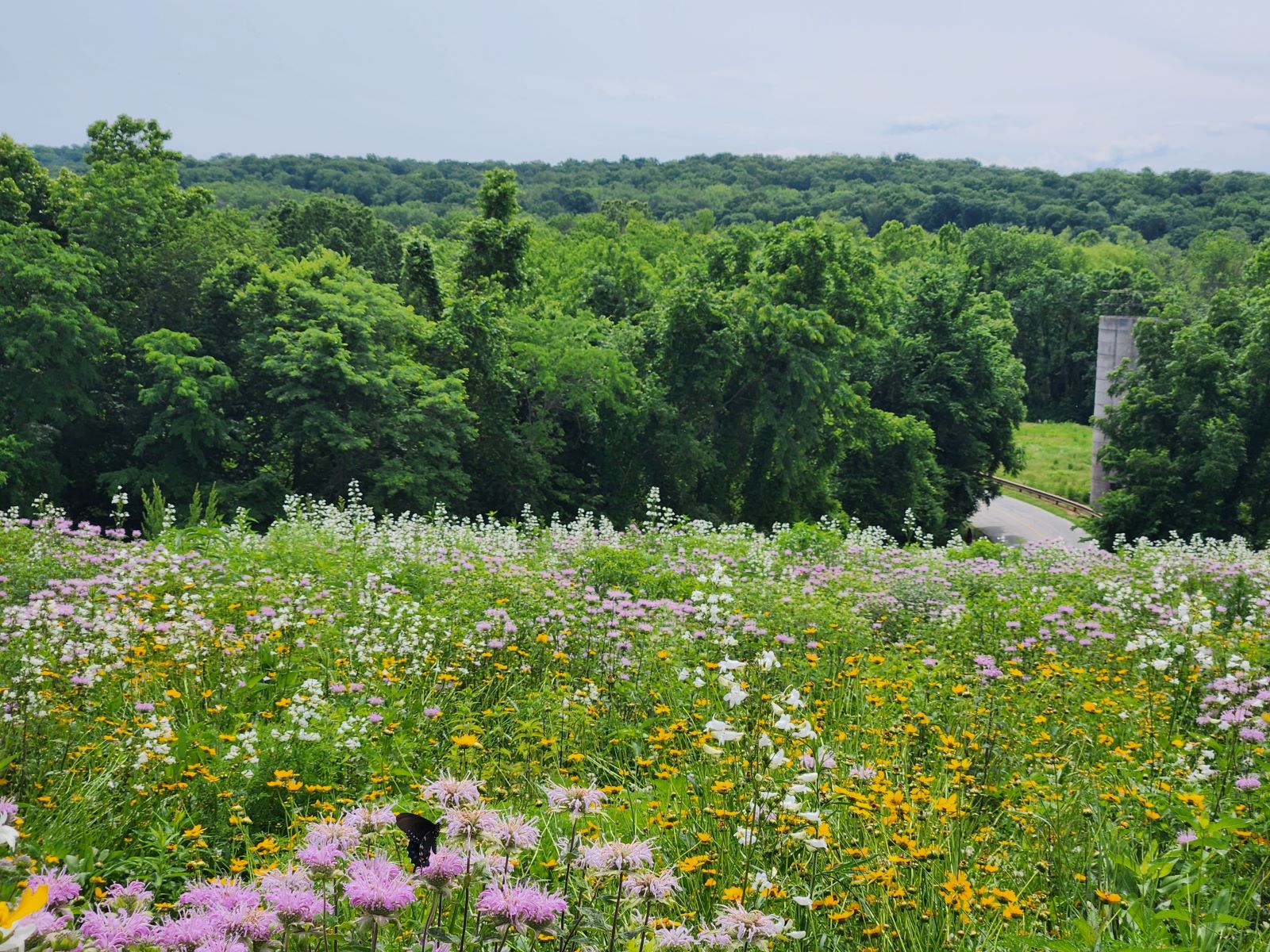
Armed with shovels designed for such tough projects, Coats and other Park Board staff members started digging out the honeysuckle, but “I had not a clue what I was doing,” he admitted.
That’s about the time he reached out to Sanders.

Then founder and director of Watershed Conservation Corps, an educational work program for young adults and part of Watershed Committee of the Ozarks, Sanders had gained expertise in removing invasive plants. With funding from a Department of Conservation grant, Sanders and his crew helped remove at least 20 acres of honeysuckle from the park of more than 150 acres.
Besides getting to know Sanders as he worked, Coats was also getting acquainted with a likable photography buff who frequented the park.
Locke was newly retired from a sales career at Ozarks Coca-Cola/Dr. Pepper Bottling Co. and could be found at Lake Springfield every day, along with his camera. Today, some of Locke’s nature photos are displayed at the Boathouse.
As Coats and Locke got acquainted and realized they shared a passion for restoring native wildlife habitats, Coats had an idea: He’d hire Locke to do some part-time work, since the more than $50,000 Department of Conservation grant for removing invasive honeysuckle at the park called for planting native species there, too.
Replanting after the 20-acre dig
Coats had just set out 30 little bluestem plants around an old silo at the park — starting what’s now known as the Silo Prairie — yet knew he needed more help with a new planting project.
Each winter, work crews would spread mulch on park embankments too steep to mow, but the mulch did little to prevent erosion. Native plants with deep roots would do more to hold the soil in place, Coats decided, so “I went up to Richard and said, ‘Hey, would you like to get on the payroll?’”

“I don’t mind working, and I love beautiful flowers,” Locke recalled, claiming that then, he “knew nothing about any species of flowers whatsoever except a sunflower.”
Even so, Locke bedded native plants at the park’s entrance and along embankments as fast as Coats could order them, Coats said: Within three years, his 70-something-year-old friend had set out some 3,000 plants.
“He took it to another level,” the 48-year-old Coats said of Locke, who in turn said Coats “allowed me to just explode my mind,” as he expanded his knowledge of the plants.
Meanwhile, as the Watershed Conservation Corps put in hours at Lake Springfield and Sanders was hired as conservation coordinator for the parks in 2022. Locke, 79, and Sanders, 36, had been getting acquainted, too. Now, Sanders is like another son to him, Locke said.
To listen to any of the three men talk about habitat restoration at the park, you might think the others should get all or at least most of the credit: Combs claims he’s only a “paper-pusher” and lauds Locke and Sanders for the groundwork, while Locke calls Combs “the impetus behind this whole thing” and “just a guy that wants to do better in the community.”
For his part, Sanders said he drives past Lake Springfield, admires the thousands of plants Locke planted by hand, “and I’m like, ‘This guy is the whole park here.’”
The prairie, Coats said, has “brought us all together. We have the same passions and we have so much in common.”
Seeding diverse species of plants
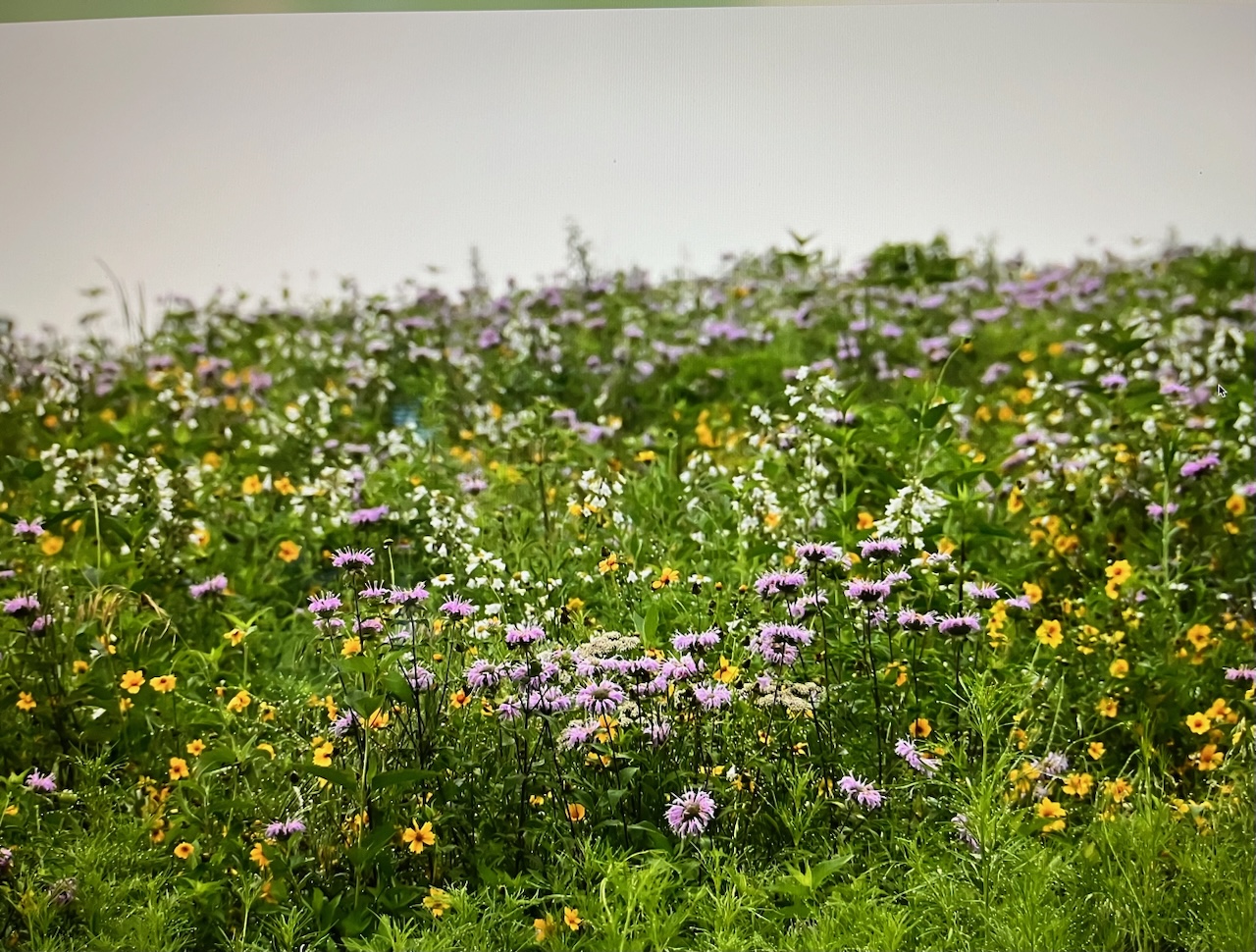
Boulevard Prairie began with Sanders custom-mixing the wildflower seeds he ordered from a Texas County supplier, then planting the prairie himself after park workers brush-hogged the acreage.
In Locke’s eyes, the prairie is “really his doin’,” he said of Sanders.
““He took dry seeds, mixed them all, and instead of broadcasting them with a machine, he just comes out here and wears his shoulder out,” said Locke, calling his young friend “a genius — a down-to-earth, calm, kind genius.”
“Go out here in the middle and go down low and find a plant that I have no idea what it is, and he knows the scientific name for it,” he added.
Crouching among the wildflowers, some still slender sprigs in the prairie’s second season, Sanders proved Locke to be correct.
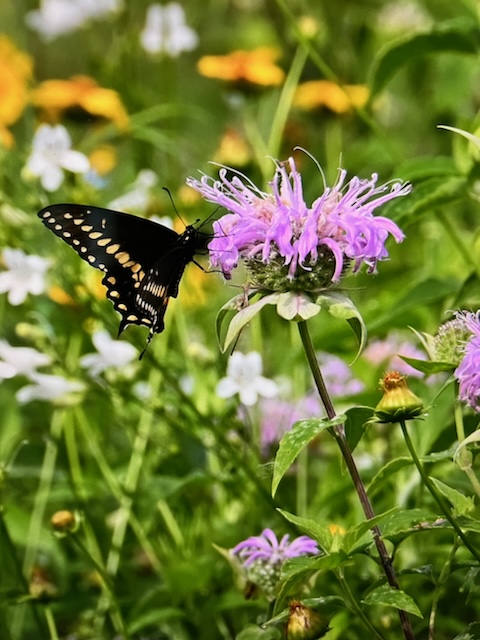
“You’ve got little bluestem grass, you’ve got hairy mountain mint — smell that,” Sanders said, rubbing the plant’s furry leaves between his fingers to release the fragrance. “Here’s some bergamot.”
The diversity of the 40-species blend of seeds on the new prairie is “quite remarkable,” Sanders said. This year and last, yellow coreopsis has covered the landscape, but someday what are now the smallest plants will prevail as coneflowers, black-eyed Susans and “a huge hodgepodge of native warm-season grasses” succeed flashier, earlier-blooming species, Sanders explained.
Touching the delicate foliage of a blazing star plant now only a few inches tall, Sanders said it could grow to a height of 5 feet within three years.
“It’s going to be neat to watch this over the next half-decade,” Sanders said, “because the coreopsis may just disappear altogether, and it’ll be replaced by some longer-lived perennial species.”
“I said, ‘Caleb, you set the bar so high,’” Coats said after returning from vacation and seeing the prairie in “super bloom.”
In his 23 years as a parks employee, Coats said, such efforts to preserve the parks' natural resources “might be one of things I’m most passionate (about) and proud of.”
Evolution of the prairie landscape
As Boulevard Prairie evolves over the next few years, Lake Springfield visitors will see other prairies spring up. Part of Lake Springfield’s Wildlife Habitat Master Plan, a one-acre Audubon Glade funded by the Greater Ozarks Audubon Society will be seeded near the park entrance in the fall of 2024, while a Sportsman’s Prairie funded by the Missouri Prairie Foundation will be planted just south of there.
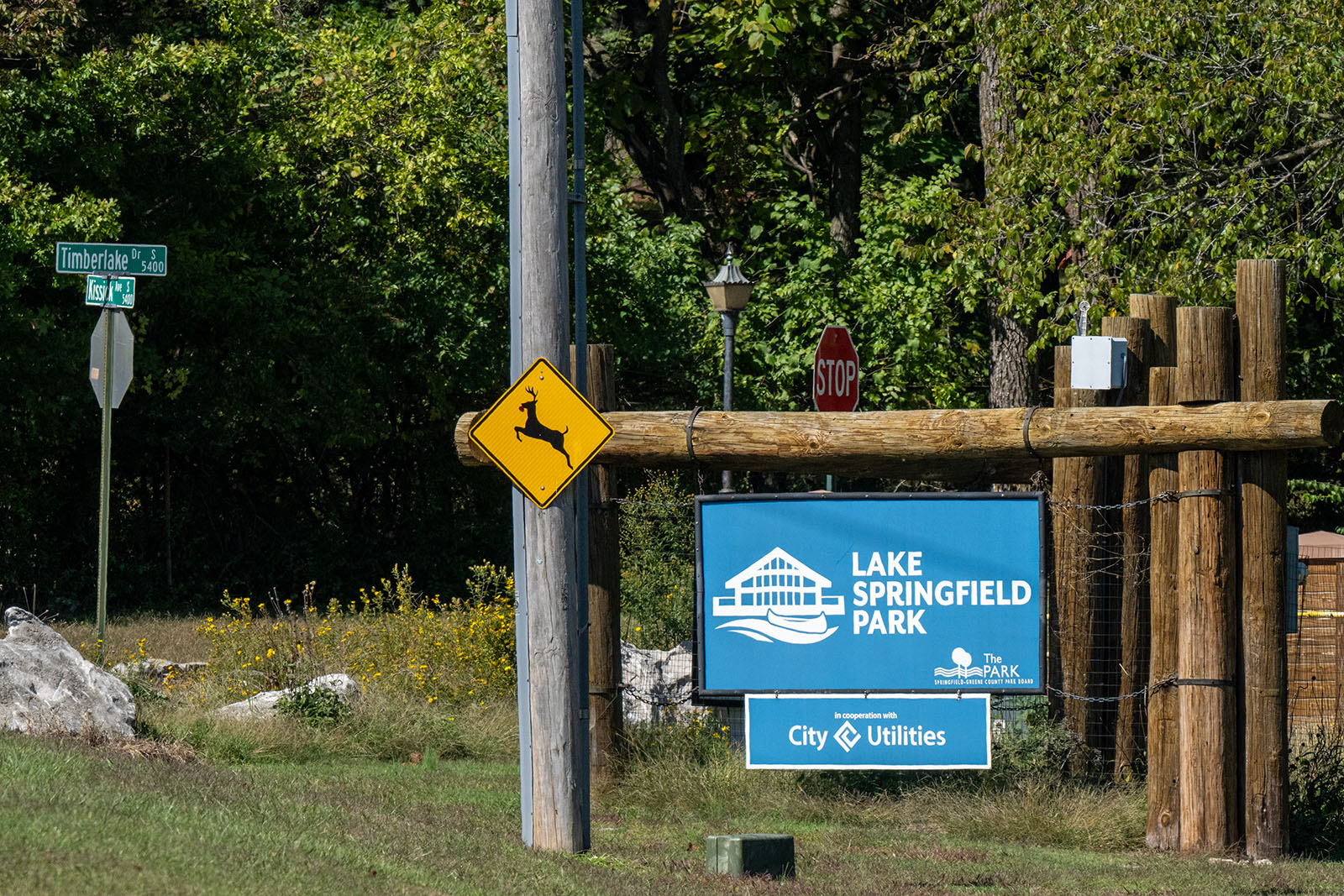
That’s not all. Locke, once familiar with only sunflowers, will soon oversee the planting of more erosion-preventing native plants along Lake Springfield embankments, thanks to a $15,000 grant from Missouri Bird Conservation Initiative.
He’s growing native plants from seed at the lake, too, just as the Park Board envisions starting a large nursery — possibly at Rutledge-Wilson Farm Park, Coats said — to grow native plants for landscaping city and county government properties like the soon-to-be-remodeled Springfield Art Museum.
Coats said there are also plans to convert 16 acres of lawn at Lost Hill Park to warm-season grasses that can be harvested for hay to feed animals at Rutledge-Wilson and Valley Water Mill Park Equestrian Center. Partial funding from the Department of Conservation will make that possible, too, he said.
Benefits beyond saving money
As Sanders continues to seek grants — and volunteers — to fund or plant more prairies within Springfield's parks, he’ll persuade patrons and potential benefactors to consider the cost-saving benefits of prairies as well as convince them of what he calls the “ecological heavy-lifting” native plants can do.
“We are definitely saving taxpayer money by doing this stuff,” Sanders said. “And then to look out here and see the way this is functioning — for people, for the planet. Look at all these pollinators out here right now.”
He and the others agree that the true benefits of the prairie can’t be easily measured. For Locke, at least, part of the prairie’s beauty is in the emotional connection people make to it.
He’s witnessed that connection in a long-time patron, now 94, who collects bugs there, or in the two friends who recently took photos of each other among the flowers the day before one of them left on a mission trip.
“When they see something like this, people are emotionally connected to something that’s beautiful,” Locke said. “It’s a calming experience for people and patrons when they come into the park. And that’s a side benefit that you can’t put dollars on.
“There’s more to it than just mowed grass.”


